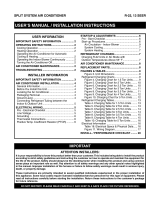
6
• Donotattempttoaddadditionaloiltomotorsunequipped
with oil tubes. The compressor is hermetically sealed
at the factory and does not require lubrication.
REFRIGERANT CHARGING
WARNING:
S6BF Split System Air Conditioners are shipped
charged with R410A refrigerant and ready
for installation. If repairs make it necessary
for evacuation and charging, it should only
be attempted by qualified trained personnel
thoroughly familiar with this equipment. Under
no circumstances should the owner attempt to
install and/or service this equipment. Failure to
comply with this warning could result in property
damage, personal injury, or death.
After refrigerant line connections are completed, it is
required that you leak check and evacuate the indoor
section and all line connections (using proper methods)
before finalizing the full system refrigerant charge.
• Refrigerant charging charts are applicable only to
matched assemblies of NORDYNE equipment and listed
airflows for the indoor coil. Refer to Figure 2, Figure 3,
Figure 4, Figure 5, & Figure 6 (pages 7, 8, &
9) for correct system charging.
• S6BFoutdoorunitswithnon-AHRIlistedindoorcoils
are not recommended. Deviations from rated airflows or
non-listed combinations may require modification to the
expansion device and refrigerant charging procedures
for proper and efficient system operation.
• Therefrigerantchargecanbecheckedandadjusted
through the service ports provided external to the outdoor
unit. Use only gage line sets which have a “Schrader”
depression device present to actuate the valve.
Charging the Unit in AC mode
(At outdoor temperatures above 55° F for
optimized sub-cooling of 10° F - 12° F.)
1. With the system operating at steady-state, measure
the liquid refrigerant pressure (in psig) at the outdoor
unit service valve.
2. Measure the liquid refrigerant temperature (in
Fahrenheit) at the service valve.
3. Determine the required liquid refrigerant pressure from
the appropriate charging chart (Figure 2, Figure 3, Figure
4, Figure 5, & Figure 6).
• IfthepressuremeasuredinStep1isgreaterthan
the required liquid refrigerant pressure determined
in Step 3, then there is too much charge in the
system. Remove refrigerant and repeat Steps 1
through 3 until the system is correctly charged.
• IfthepressuremeasuredinStep1islessthanthe
required liquid refrigerant pressure determined in
Step 3, there is too little charge in the system. Add
refrigerant and repeat Steps 1 through 3 until the
system is correctly charged.
System Cooling
1. Set the thermostat’s system mode to COOL and the
fan mode to AUTO. Gradually lower the thermostat
temperature setpoint below room temperature and
verify the outdoor unit and indoor blower energize.
2. Verify blower wheel is spinning in direction indicated by
arrow. Feel the air being circulated by the indoor blower
and verify that it is cooler than ambient temperature.
Listen for any unusual noises. If unusual sounds occur,
determine the source of the noise and correct as
necessary.
3. Verify HI and LO refrigerant pressures.
4. Allow the system to operate for several minutes
and then set the temperature selector above room
temperature. Verify the fan and compressor cycle off
with the thermostat. NOTE: The blower should also
stop unless fan mode is set to the ON position.
System Heating (optional)
1. Set the thermostat's system mode to HEAT and the
temperature mode above room temperature.
2. Verify the optional heating equipment (furnace or
electric heat) and indoor blower energize. Feel the air
being circulated by the indoor blower and verify that
it is warmer than ambient temperature. Listen for any
unusual noises. If unusual sounds occur, determine the
source of the noise and correct as necessary.
AIR CONDITIONER MAINTENANCE
WARNING:
To prevent electrical shock, personal injury, or
death, disconnect all electrical power to the unit
before performing any maintenance or service.
The unit may have more than one electrical supply.
Proper maintenance is important to achieve optimum
performance from the air conditioner. The ability to properly
perform maintenance on this equipment requires certain
mechanical skills and tools. If you do not possess these
skills, contact your dealer for maintenance. Consult your
local dealer about the availability of maintenance contracts.
Routine maintenance should include the following:
• Inspectandcleanorreplaceairltersatthebeginning
of each heating and cooling season, or more frequently
if required.
• Inspectthecondensatedrainandoutdoorcoilatthe
beginning of each cooling season. Remove any debris.
Clean the outdoor coil and louvers as necessary using a
mild detergent and water. Rinse thoroughly with water.
• Inspecttheelectricalconnectionsfortightnessatthe
beginning of each heating and cooling season. Service
as necessary.
CAUTION:
The unit should never be operated without a
filter in the return air system. Replace disposable
filters with the same type and size.












